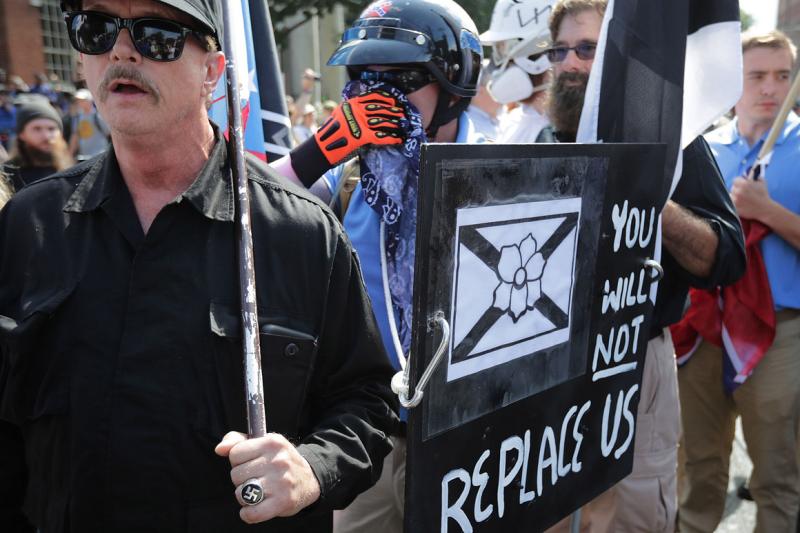How Will History Books Remember the 2010s? We asked 23 top historians to write the paragraph that will describe the past decade, 100 years from now.

This is a long article. I excerpted parts of it. You can read the rest at the link.


We aren’t just approaching the end of a very newsy year; we’re approaching the end of a very eventful decade. To mark the occasion, Politico Magazine asked a group of historians to put all that happened over the past 10 years in its proper historical context—and literally write the paragraph that they think will describe the 2010s in American history books written a century from now.
Will the seemingly significant events we have lived through this decade be important in the grand scheme? Are there powerful historical forces playing out that we’re missing? Where will Black Lives Matter, the social media revolution, #MeToo, climate change, Barack Obama and Donald Trump fit into the history books?
Many described the 2010s, in the words of Andrew Bacevich, as an era of “venomous division,” characterized by massive racial, economic and political divisions. Some saw hope in the discord—as a catalyst for much needed reform, soon to come. Still other historians pointed out less-noticed trends—in technology and foreign policy—that will resonate far into the future.
How will the future remember the 2010s? Here’s what the experts had to say:
The innovation of white supremacy
Marcia Chatelain is a professor of history and African American studies at Georgetown University.
The 2010s were characterized by the seeming dissonance of the 2016 presidential election. In that election, Donald J. Trump expertly galvanized racial resentments, manipulated a bifurcated media landscape and utilized his alliances with foreign governments to become president. Although it was unremarkable for a racist to become president of the United States, the election of the former reality television star immediately after former Senator Barack Obama, the first black man elected to the office, led some observers to believe that his presidential win was a sign of racial backlash, a phenomenon repeated across American history since the end of slavery. Trump’s election was distinct in that it helped highlight the centrality of technology in the efficient reproduction and circulation of racist ideologies, and it forced the public to confront tensions between an expanding public sphere and its ability to galvanize narrow-minded and socially dangerous thinking. On the cusp of 2020, Americans alarmed by the spread of falsehoods via the Internet and the radicalization of racists through social media channels realized that the ideology of white supremacy—with its longstanding ability to shapeshift to meet the demands of the day—had innovated alongside the technology industry.
The end of privacy
Vanessa Walker is the Morgan assistant professor of diplomatic history at Amherst College.
At the close of the 2010s, political polarization, reactionary nationalism and escalating public conflict over systemic racism, gender inequality and climate change dominated characterizations of the decade. Less noticed, the decade marked the end of privacy. State surveillance was nothing new. The war on terror in the aughts had already ushered in new invasive profiling practices. But the pervasive, hyper-individualized, corporate-based collection and aggregation of personal data in partnership with government marked a new frontier in surveillance. The collection of personal information through individuals’ phones, computers and virtual assistants—and the social media and online platforms they utilized—informed almost every aspect of social and political interactions. Over the decade, these instruments insinuated themselves into peoples’ everyday lives for convenience, for entertainment, for basic daily information and communication in a way that made it difficult to imagine functioning without them. Like the proverbial frog being boiled alive, people became accustomed not only to trading their personal information for basic services, but also the idea that they were always being watched. Appeased by the pretense of being able to “opt out,” consumers accepted vague assertions that data collection was consensual, anonymous and secure. Yet, as the decade drew to a close, law enforcement officials, political campaigns and foreign governments increasingly used information gathered for commercial purposes in ways completely at odds with the assurances of privacy and consent. ...
The collapse of vital infrastructures
Sarah E. Igo is a professor of history and political science at Vanderbilt.
In the 2010s, Americans reckoned with their neglect of vital infrastructures: political, technological and environmental. Their constitutional democracy was the most obvious system in disarray. Vulnerable to Russian cyberattacks during the 2016 election, U.S. political institutions suffered equally from the unchecked flouting of governing norms by the reality-TV star president, Donald Trump, who was the beneficiary of those attacks. Americans’ communications infrastructure also proved precarious. As news and exchanges of all sorts moved onto electronic platforms in that decade, they became ever-more captive to corporate profits, eroding individual privacy as well as the means for achieving verifiable facts. Finally, in common with people around the world, Americans grasped in that decade the potentially irreversible harm humans had done to the natural systems supporting life on the planet. Raging fires, hurricanes and floods; attacks on democratic processes; social media surveillance and fake news. These were the shocks that exposed the fragility of the systems Americans depended on—but that also galvanized citizens to repair them in the 2020s.
The two faces of American democracy
Peniel Joseph is a professor of history and public affairs at the University of Texas at Austin.
The story of the second decade of the 21st century is one marked by the Janus-faced nature of American democracy. Barack Obama, the nation’s first black president, ushered in his own version of Lyndon Johnson’s Great Society through passage of sweeping health care legislation. The promise of a more just and fair society proved elusive however, undercut by growing disparities between the rich and the poor; the rise of mass incarceration; racial and economic segregation in neighborhoods and public schools; and an assault on the concept of American citizenship and democracy fueled by right wing social media, white nationalism, anti-immigrant and anti-Muslim sentiment. President Donald Trump’s ascension represented the literal and figurative inversion of the grand hopes of the Obama Era. Whereas Obama offered the hope of racial reconciliation based on a democracy expansive enough to embrace the historically marginalized and oppressed, Trump’s electoral coalition resounded with Americans longing for the sepia-toned past, one suffused with white supremacy. These dueling narratives of American democracy reverberated globally as well. The Obama Doctrine vowed to end international war through peace efforts (including the Iran Nuclear Deal) that at times upset allies. In contrast, the Trump Doctrine touted “America First” as a slogan that signaled the abandoning of longstanding alliances in favor of a more insular foreign policy—one that saw an American president openly courting authoritarian leaders in North Korean and Russia.
Polarization and the rise of politically active women
Heather Cox Richardson is a history professor at Boston College.
The perfect symbol of the 2010s came in February 2015, when an image of a dress went viral on social media as Americans fought over whether its pattern was #blackandblue or #whiteandgold. America was divided in this decade, with splits over economics, politics, religion and culture exacerbated by social media. A set of increasingly extreme Republicans stayed in power by convincing voters that Democrats under biracial president Barack Obama, whose signature piece of legislation was the Affordable Care Act making health care accessible, were intent on destroying America by giving tax dollars to lazy people of color and feminists who wanted to murder babies. And in 2016, Republicans leaders weaponized social media with the help of Russians to elect to the White House Donald J. Trump, who promised to end this “American carnage.” On the other side, in 2013, the rise of the Black Lives Matter Movement helped galvanize those who believed the system was stacked against them. And in January 2017, the day after Trump’s inauguration, the Women’s March became the largest single-day protest in American history. By the end of that year, the #MeToo Movement took off as women shared their ubiquitous experiences with sexual harassment and demanded an end to male dominance. In 2018, when Republicans forced through the Senate the Supreme Court nomination of Brett Kavanaugh, who had been creditably accused of sexual assault, they helped convinced voters to elect a historic number of women and racial minorities to Congress in in the 2018 midterm elections, almost entirely on the Democratic side. The story of the 2010s is of increasing American polarization, but also the rise of politically active women to defend American democracy against the growing power of a Republican oligarchy.
A period of paralysis
Kevin Kruse is a history professor at Princeton University.
The 2010s were a period of paralysis. From the Tea Party protests in 2010 through the impeachment of President Donald J. Trump in 2019, the American political system staggered from one partisan showdown to another. Amplified by the growth of partisan media, both on cable and the internet, Americans increasingly lined themselves into hostile camps with all political progress stalled. The federal government shut down three times due to funding impasses, while routine matters of housekeeping like the debt ceiling became, in the words of Senate Minority Leader Mitch McConnell in 2011, “a hostage worth ransoming.” As the government gridlocked, little progress was made on larger social concerns. There were, to be sure, notable changes such as the legalization of same-sex marriage in 2015, but on other issues little progress was made. The increasing crisis in climate change, which manifested in record temperatures and alarming levels of hurricanes, flooding and wildfires, only continued to worsen. Mass shootings accelerated as well, with four of the five deadliest incidents in U.S. history taking place in the decade, with little substantial action. The optimism over race relations that had marked the election of the first African American president, meanwhile, became dashed with the revival of white nationalist extremism and divisive fights over immigration from Muslim-majority nations and a proposed border wall with Mexico. By the end of the decade, the United States seemed more deeply divided and directionless than it had been in a half century.
A pathway to a new beginning
Jeremi Suri is a professor of public affairs and history at the LBJ School at the University of Texas Austin.
The decade began with the nation’s worst recession since the Great Depression and it ended with the worst political divisions since the close of the 19th century. The inherited institutions and practices of democracy in the United States took a repeated beating. In the last weeks of the decade, the House of Representatives impeached President Donald Trump while his supporters defended near-monarchical powers for the commander-in-chief. Nonetheless, the crises that dominated the decade were transitional. They marked the demise of a still white, post-industrial, baby-boomer society filled with men and women resisting their decline. The decade opened a new America that was more racially and ethnically diverse, more feminine, led by millennials, and organized around artificial intelligence technologies. 2020 was a powerful new beginning built on the destruction of the previous years. The United States renewed its democracy through a messy, prolonged and ultimately productive generational change in leadership at all levels— from local businesses and schools to the White House. It was an ugly time that generated bright reforms thereafter.






Groundwork for a Constitutional revision
Jack Rakove is a professor of history and political science, emeritus, at Stanford University.
The decade of the 2010s placed the American constitutional system under the greatest stress it had known since the New Deal crisis of the 1930s. President Donald Trump demonstrated that he felt none of the “veneration” (to quote James Madison’s 49th Federalist paper) required to sustain the norms of constitutional governance. Worse still, however, was the behavior of the Senate and the Supreme Court. Under Republican control, the Senate blithely ignored the well-documented charges under which the House of Representatives had impeached Trump. For its part, the conservative-dominated Supreme Court fulfilled its long-frustrated agenda: In two leading decisions in June 2020, it gutted the Affordable Care Act and authorized individual states to impose severe limits on the right to choice secured in the 1974 decision in Roe v. Wade.
The events of the 2010s thus set the stage for the Great Constitutional Revision of 2024. Although Joe Biden defeated Trump in the 2020 election, Republicans held on to the Senate and the Supreme Court retained its conservative majority. With the national government in a state of near paralysis, a coalition of blue states coalesced to demand a constitutional convention. A phalanx of 18 solidly red states, representing less than a fifth of the nation’s population, quickly rejected this proposal, keeping it two states shy of the two-thirds margin that Article V of the Constitution required. Invoking the precedent set in 1787, when the first Constitutional Convention threw out the amendment rules laid down in the Articles of Confederation, the blue states insisted that the meeting must be held. Rather than side with the smaller bloc of solidly red states, the now hotly contested states of Texas and Florida sent delegations to the Chicago convention. The dominant theme of the Convention was to make constitutional decision-making directly responsive to the one person, one vote standard. That was also how votes were allocated in the Convention itself. The resulting deliberations led to a radically revised Constitution. Among other changes, the president would now be elected by a single nation-wide popular vote. The House of Representatives was enlarged to 600 members, with all its districts designed by an AI process to be as competitive as possible. The Senate became an advisory body that could no longer vote down legislation enacted by the House, and senators were now elected on a regional basis, rather than by individual states. The Supreme Court was enlarged to 15 justices, who would serve 18-year terms on a staggered basis. When the bloc of small red states balked at ratifying the results, they were told they could form their own separate confederacy. A few months of considering how costly it would be to sustain their states government without the financial support of the far more economically productive blue states quickly led them to abandon their position.
Trump’s one inadvertent contribution to American history was to make these changes possible.
1. The decline of the American Experiment.
2. The acceptance of the concept of alternative facts.
3. The power of wealth over the power of the collective.
and might be a little bit out of her mind. I mean,
It's "foreign governments" plural now? Not just Russia? Is this lady really claiming that but for these foreign governments Trump would not be president? As wacky as the Democratic House can sometimes seem, even they aren't acting like they think that is true.
Cuz that's the limit of his résumé and why he got votes. He was on TV. Wow.
She might be obsessing a little. I get it. She teaches African American studies (btw, what job does that lead to anyway? I mean besides teaching African American studies) so she's probably in the habit of focusing on this stuff. But for about 90-something % of the rest of America, white supremacy just isn't a normal part of their lives or their thoughts.
She's a ray of sunshine, isn't she?
When I go outside, I just see folks going about their business. I feel like this lady might be watching too much CNN. However, this:
actually is an interesting and very real phenomenon.
Her students fondly call her Chicken Little.
Damn lady. Thinking about ending it all? I hear screaming at the sky helps.
Seriously what's precarious about our communications infrastructure? We've never had better communication! When have the systems we used not been intertwined with (or "captive to" )corporate profits? That's what drives the development of that infrastructure she's so worried about. And, oh yeah, fires and nasty weather. There's something that's brand new.
)corporate profits? That's what drives the development of that infrastructure she's so worried about. And, oh yeah, fires and nasty weather. There's something that's brand new.